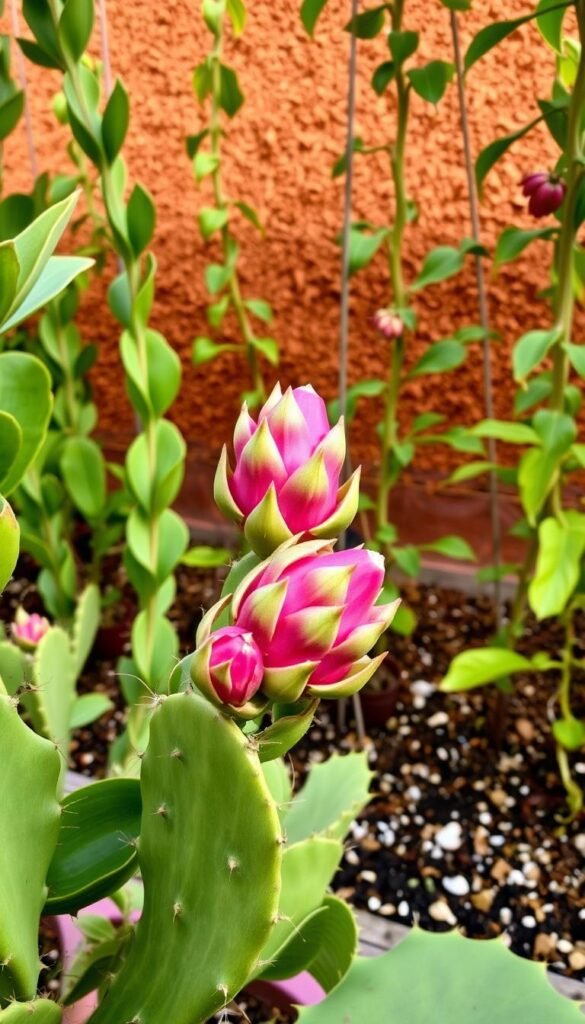Imagine biting into a sweet, juicy dragon fruit plucked straight from your backyard. Unlike store-bought versions—which are harvested unripe—homegrown varieties burst with tropical flavor. This subtropical cactus thrives in warm climates but can adapt to containers if you live outside USDA zones 10-11. Its vibrant pink fruits and night-blooming flowers make it a showstopper in any garden.
Why has this exotic plant gained popularity? For starters, it offers a rewarding challenge unlike typical desert cacti. While it demands well-draining soil and consistent watering, the payoff is worth it: nutrient-rich fruits you can’t find ripe on supermarket shelves. With proper care, your first harvest could arrive in 1-2 years.
Success hinges on three critical factors: soil quality, structural support, and pollination methods. The right blend of organic matter and drainage prevents root rot, while sturdy trellises accommodate its climbing nature. Unlike many plants, some varieties require hand-pollination to produce fruit—a fascinating process you’ll master with practice.
Whether you’re in Florida or growing indoors in colder states, this guide prepares you for every step. Let’s unlock the secrets to cultivating these dazzling tropical gems at home.
Setting Up the Perfect Soil and Potting Mix
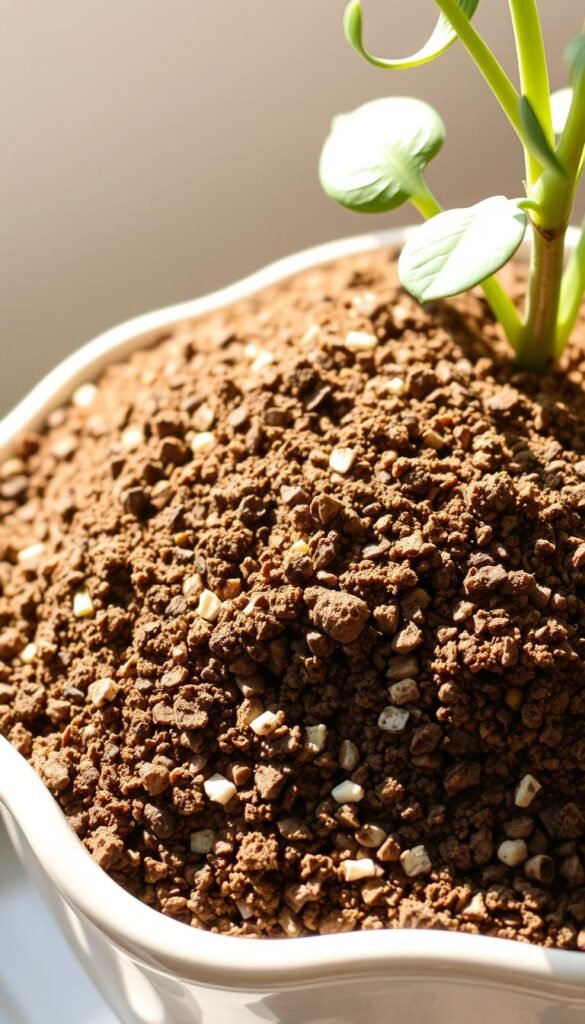
Creating the ideal foundation for your tropical cactus starts beneath the surface. Unlike their desert cousins, these plants demand rich organic matter paired with exceptional drainage. Get this balance right, and you’ll see vigorous growth that leads to those coveted jewel-toned fruits.
Selecting Well-Draining Soil
Desert cactus mixes won’t cut it here—your plant craves moisture without soggy roots. A 50-30-20 blend of potting soil, perlite, and sand works like magic. The perlite creates air pockets, while sand prevents compaction. If using store-bought cactus soil, mix in compost for nutrients and extra perlite for winter drainage.
Balancing Nutrients and pH
Test your soil’s acidity with a $10 kit from any garden center. Aim for 6.0-7.0 pH—slightly acidic keeps nutrients available. Boost organic content with aged manure or worm castings. These feed microbes that help roots absorb minerals. Pro tip: Refresh the top 2″ of container soil each spring with compost.
Choose pots at least 15″ wide with multiple drainage holes. Terra cotta breathes better than plastic, reducing rot risks. For ground planting, mound the soil 6″ high to improve runoff. Remember: happy roots mean bountiful harvests!
Building Effective Support Structures for Your Dragon Fruit
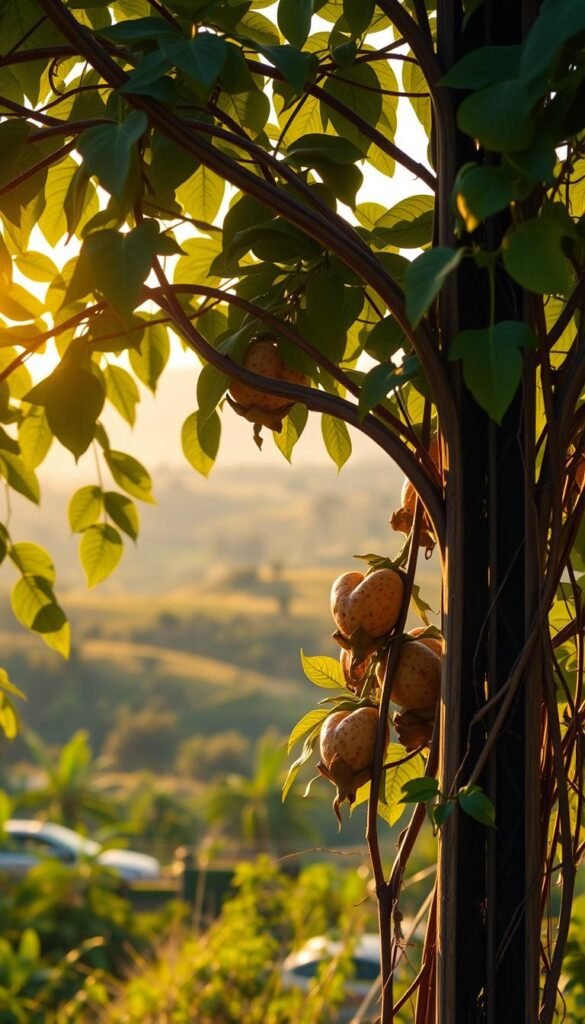
Strong support isn’t just helpful—it’s essential for your plant’s success. Unlike traditional cacti, these tropical climbers produce heavy stems and fruit that demand robust frameworks. Without proper anchoring, mature specimens can collapse under their own weight, especially during storms or heavy fruiting.
Choosing the Right Trellis and Anchoring Methods
Start with a 4×4 untreated cedar or redwood post, sunk 10-12″ into a concrete pier block. This creates a rock-solid base that withstands decades of growth. For young cuttings in pots, pair 18″ bamboo stakes with soft ties to guide upward development without damaging tender stems.
The magic happens at the top. Once your main post reaches 4-6 feet, add a 2×4 lumber square frame. This “crown” supports the plant’s wild upper branches as they sprawl horizontally. Think of it as a jungle gym for your green companion!
Ground planting? Bury pier blocks deeper in sandy soils. Container growers should opt for heavier pots to counterbalance top-heavy growth. For tight spaces, check out our guide on DIY trellises that maximize vertical growth.
Pro tip: Inspect connections annually—loose joints cause 80% of trellis failures. A well-built system becomes part of your garden’s backbone, literally and figuratively!
Mastering Pollination Techniques to Maximize Fruit Yield
Timing is everything when working with these nocturnal bloomers. Their flowers open like clockwork at dusk, glowing under moonlight before wilting by sunrise. To catch this fleeting moment, you’ll need sharp eyes and a soft brush.
Spotting Buds and Predicting Blooms
Watch for tiny bumps forming where thorns meet stems—these signal future flowers. Once a bud swells to pea size, mark your calendar: blooms arrive in 4-5 weeks. Check plants nightly as the date nears. Pro tip: Use colored tape to track developing buds across multiple stems.
The Art of Hand Pollination
Even self-fertile types like ‘Vietnam White’ produce more fruit when manually pollinated. Wait until petals fully unfurl, then gently swipe pollen from one flower’s center to another. A makeup brush or cotton swab works perfectly. Repeat this dance between 8 PM and midnight for best results.
| Variety | Pollination Needs | Best Time to Pollinate |
|---|---|---|
| Sugar Dragon | Self-fertile (needs hand help) | 9-11 PM |
| Physical Graffiti | Requires cross-pollination | 10 PM-12 AM |
| American Beauty | Self-sterile | 8-10 PM |
Hot nights accelerate flower closure—have tools ready! Cooler evenings? You gain extra hours. Always store leftover pollen in the fridge for next-day use. With practice, you’ll turn brief blooms into baskets of sweet rewards.
Growing a Dragon Fruit Garden: Potting Mix, Support Structures, and Pollination – A Step-by-Step Guide
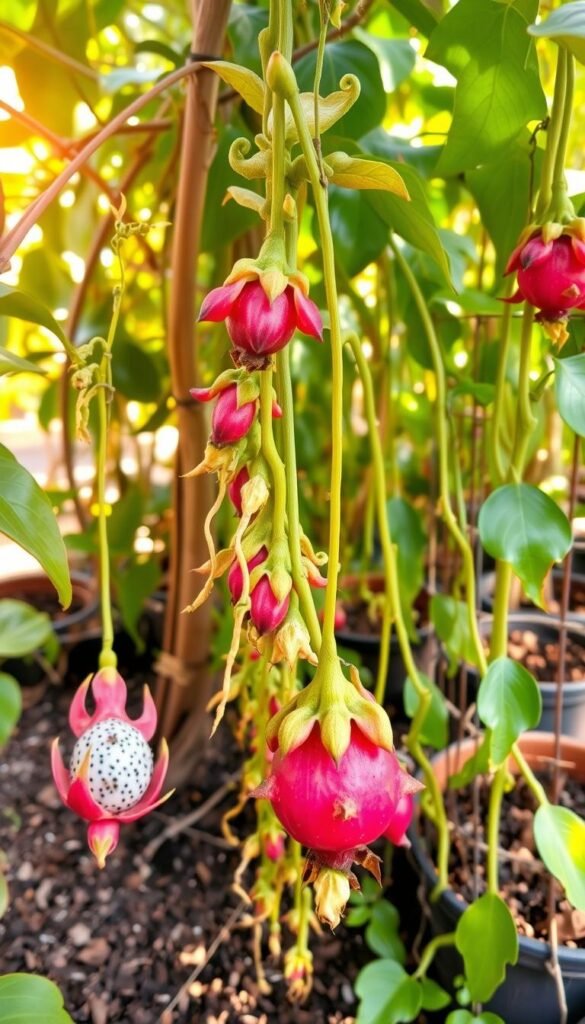
Your journey from planting to harvest follows a precise rhythm. Begin with cuttings—they skip years of waiting compared to seeds. Nestle them 1-2″ deep near a sturdy post, securing stems with soft garden tape. This gentle hug prevents wobbling while roots establish.
Comprehensive Steps from Planting to Fruiting
First six months: Focus on root development. Water deeply but infrequently, letting soil dry between sessions. Feed monthly with high-nitrogen fertilizer to fuel upward growth. When stems reach your trellis crown, grab those pruners!
Topping transforms gangly vines into productive bushes. Snip the main stem’s tip once it grows 2-3″ beyond the support. This triggers side shoots that’ll bear future flowers. Pro tip: Save cuttings—they make perfect backups or gifts!
Year two brings magic. Watch for knobby buds where thorns meet stems. These swell into night-blooming flowers over 4-5 weeks. Hand-pollinate at peak bloom using a soft brush, then track fruit development:
| Stage | Duration | Key Signs |
|---|---|---|
| Bud formation | 35-50 days | Green scales appear |
| Flowering | 1 night | Fully open blooms |
| Fruit maturation | 25-30 days | Color change from green |
Adjust care as seasons shift. Reduce water in winter when growth slows. Come spring, refresh soil nutrients with compost tea. With this rhythm, you’ll taste success—literally—within 18-24 months.
Planting, Transplanting, and Propagation Strategies
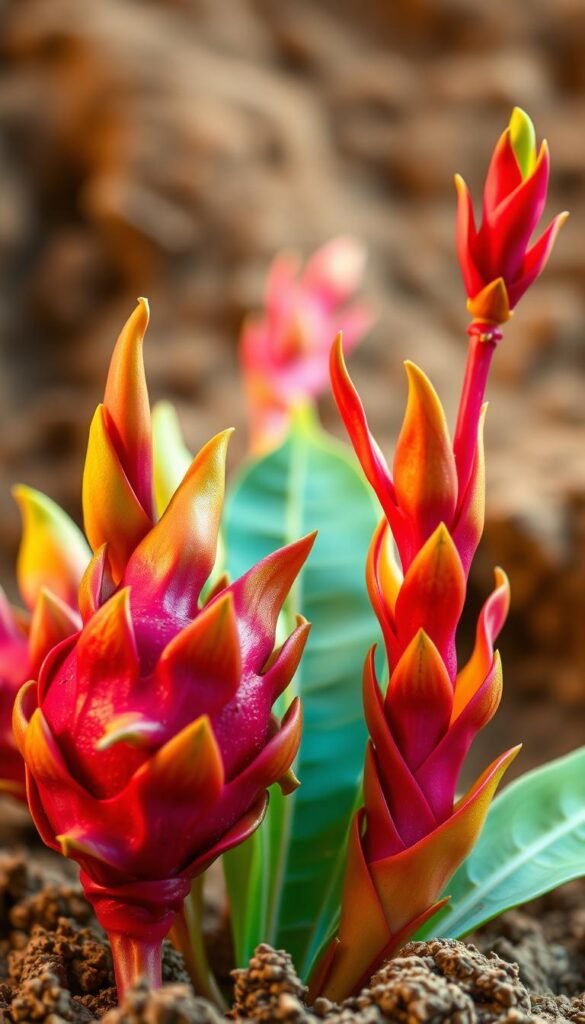
Getting your dragon fruit journey off to a strong start begins with smart propagation choices. While seeds might seem tempting, cuttings offer reliability and faster results. Let’s explore how to set up new plants for success while avoiding common pitfalls.
Benefits of Starting with Healthy Cuttings
Vegetative propagation guarantees fruit identical to the parent plant—no genetic surprises. Look for 7-8″ segments from mature stems with a woody base. These contain stored energy for rapid root growth. Plant them 1″ deep in shaded areas for 2-4 weeks, letting roots develop without sunlight stress.
Watch for whitish-green nodes near leaf bases—your signal to gradually introduce sunlight. Spring planting aligns perfectly with warm soil temperatures above 60°F. This timing gives cuttings 3-4 months to establish before cooler weather arrives.
Managing Transplant Shock and Ensuring Root Stability
When moving rooted cuttings, water thoroughly 24 hours pre-transplant. Use original soil around roots to maintain microbial balance. Pro tip: Wrap delicate stems in burlap during transfers to prevent breakage.
Check stability weekly by gently tugging plants. Resistance means roots have anchored. If stems wobble, add temporary bamboo stakes until new growth appears. Most specimens adjust within 2-3 weeks when kept in partial shade initially.
Optimizing Care: Watering, Fertilizing, and Seasonal Adjustments
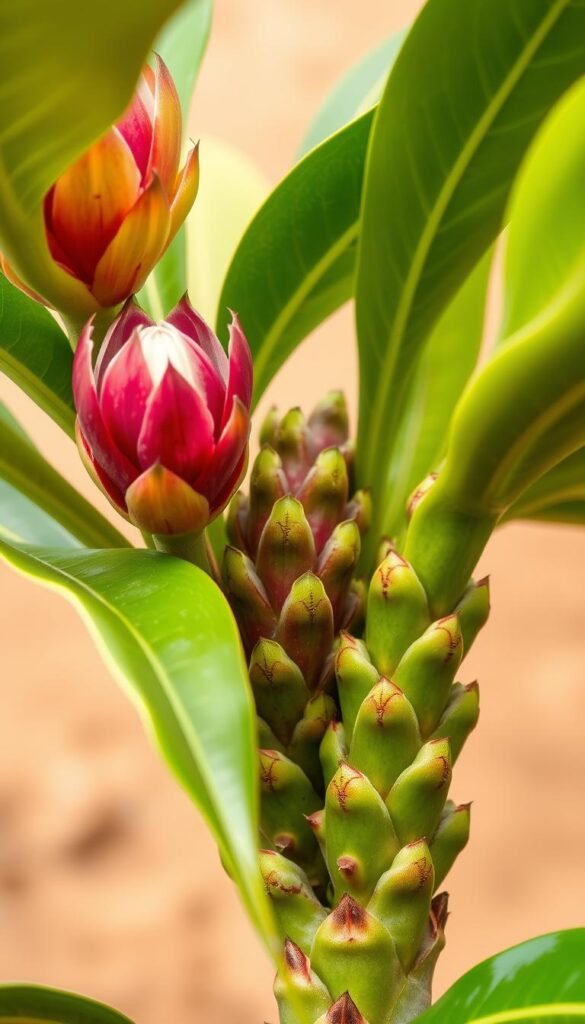
Your tropical cactus thrives when its care aligns with nature’s calendar. Unlike predictable desert species, it dances to seasonal rhythms—demanding more attention in growth phases and less during dormancy. Let’s decode its yearly needs.
Adjusting Water and Nutrient Levels Through the Seasons
Summer turns your plant into a hydration heavyweight. Water every 48 hours when temperatures soar above 85°F. Check soil moisture with the finger test: if dry 1″ down, it’s drink time. Pair this with 30% shade cloth during heatwaves to prevent sunscald.
Winter calls for restraint. Water weekly unless rains arrive. “In colder months, overwatering kills more plants than drought,” notes Arizona grower Luis Ramirez. Use room-temperature water to avoid shocking roots.
| Season | Water Frequency | Key Fertilizer |
|---|---|---|
| Spring | 3x weekly | 10-5-5 (Nitrogen-rich) |
| Summer | Every 2 days | 5-10-10 (Potash boost) |
| Fall/Winter | 1x weekly | None (Dormancy phase) |
Spot trouble early: yellow stems signal overwatering, while shriveled tips beg for hydration. Coastal growers might water less than desert dwellers—adapt these guidelines to your local climate. With seasonal savvy, you’ll keep your green companion thriving year-round.
Wrapping Up Your Dragon Fruit Journey with a Bountiful Harvest
Your patience pays off when those vibrant dragon fruit finally blush ripe on the vine. Unlike store-bought options, homegrown varieties offer explosive sweetness you can’t buy. With proper care, your living investment thrives for decades—some specimens produce for 20+ years!
Success boils down to three pillars: balanced soil, sturdy supports, and timely pollination. Nail these, and you’ll see rapid growth—stems can stretch inches overnight! Most cuttings bear fruit within 18 months, outpacing seed-grown plants by years.
Keep an eye on mature plants. Prune overcrowded stems to boost airflow and prevent rot. Rotate container-grown varieties weekly for even sun exposure. Remember: consistent care beats perfect conditions every time.
As seasons change, so do your rewards. Each harvest teaches something new—whether testing varieties or refining pruning techniques. Share extras with neighbors or freeze pulp for smoothies. Your tropical treasure now roots deeper than soil—it’s part of your story.

